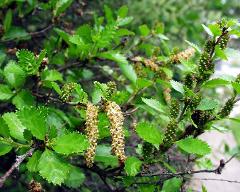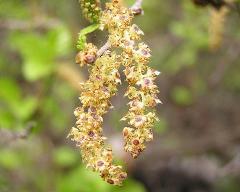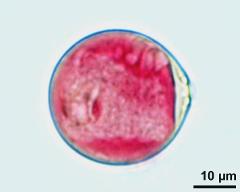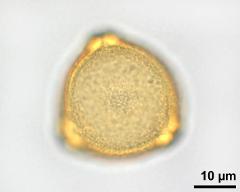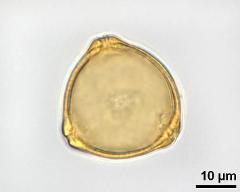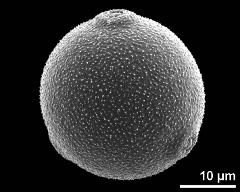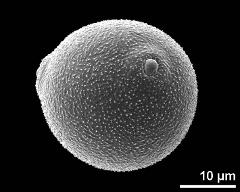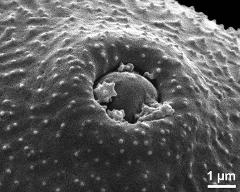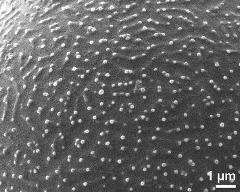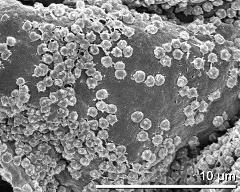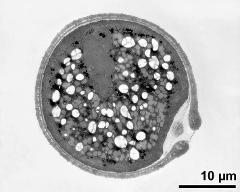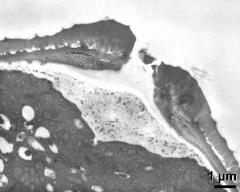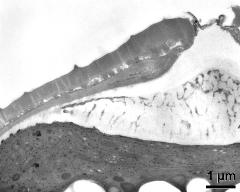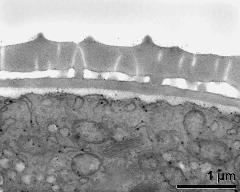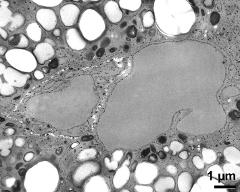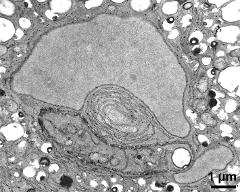Betula humilis
Taxonomy: Spermatophyta, Fagales, Betulaceae, Betula
Published: 2005-06-01
Pollen Description
Shape, Size and Aperture
pollen unit: monad, dispersal unit and peculiarities: monad, size (pollen unit): small (10-25 µm), size of hydrated pollen (LM): -, shortest polar axis in equatorial view (LM): -, longest polar axis in equatorial view (LM): -, shortest diameter in equatorial or polar view (LM): -, longest diameter in equatorial or polar view (LM): -, pollen class: -, polarity: isopolar, P/E-ratio: -, shape: spheroidal, outline in polar view: circular, dominant orientation (LM): -, P/E-ratio (dry pollen): -, shape (dry pollen): irregular, outline in polar view (dry pollen): irregular, infoldings (dry pollen): irregularly infolded, aperture number: 3, aperture type: -, aperture condition: porate, aperture peculiarities: operculum, oncus, annulus
Ornamentation and Structure
LM ornamentation LM: psilate, nexine: -, sexine: -, SEM ornamentation SEM: granulate, rugulate, suprasculpture SEM: -, TEM tectum: eutectate, infratectum: columellate, foot layer: continuous, endexine: absent, intine: monolayered, wall peculiarities: -, supratectal element: -
Miscellaneous
pollen coatings: absent, reserves in cytoplasm: starch, cell number: 2-celled, Ubisch bodies: present
Annotations: tectum very mighty. Dry pollen infoldings irrgular but only interapertural areas sunken.
Author(s) of diagnosis: Halbritter, H.; Diethart, B.
Pictures
Picture legend
- flower(s), photographer: Halbritter, H.
- flower(s), photographer: Diethart, B.
- pollen grain with generative cell - dry, rehydrated (water), aceto-carmine, photographer: Diethart, B.
- upper focus - dry, acetolyzed, unstained, photographer: Diethart, B.
- optical section - dry, acetolyzed, unstained, photographer: Diethart, B.
- lower focus - dry, acetolyzed, unstained, photographer: Diethart, B.
- polar view - fresh, rehydrated (water) & critical point dried & sputter coated with gold, photographer: Halbritter, H.
- equatorial view - fresh, rehydrated (water) & critical point dried & sputter coated with gold, photographer: Halbritter, H.
- aperture - fresh, rehydrated (water) & critical point dried & sputter coated with gold, photographer: Halbritter, H.
- exine surface - fresh, rehydrated (water) & critical point dried & sputter coated with gold, photographer: Halbritter, H.
- dry pollen grains - dry, sputter coated with gold, photographer: Halbritter, H.
- anther wall with Ubisch bodies - fresh, rehydrated (water) & critical point dried & sputter coated with gold, photographer: Diethart, B.
- pollen grain in cross section - fresh, glutaraldehyde & osmium & potassium ferrocyanide, lipid-test, photographer: Diethart, B.
- apertural area of pollen wall - fresh, glutaraldehyde & osmium & potassium ferrocyanide, modified Thiéry-test, photographer: Diethart, B.
- pollen wall at transition of aperture and interapertural area - fresh, glutaraldehyde & osmium & potassium ferrocyanide, lipid-test, photographer: Diethart, B.
- interapertural area of pollen wall - fresh, glutaraldehyde & osmium & potassium ferrocyanide, lipid-test, photographer: Diethart, B.
- stacked endoplasmatic reticulum - fresh, glutaraldehyde & osmium & potassium ferrocyanide, lipid-test, photographer: Diethart, B.
- generative cell and vegetative nucleus - fresh, glutaraldehyde & osmium & potassium ferrocyanide, lipid-test, photographer: Diethart, B.
- generative cell and vegetaive nucleus - fresh, glutaraldehyde & osmium & potassium ferrocyanide, lipid-test, photographer: Diethart, B.
Literature
- (2003) Betulaceae and Corylaceae. In: The Northwest European Pollen Flora 65. Rev Palaeobot Palynol 123: 71-98
Copyright and Citation
Cite this publication as:
Halbritter H., Diethart B. 2005. Betula humilis. In: PalDat - A palynological database. https://www.paldat.org/pub/Betula_humilis/108732;jsessionid=D583B7D19FA335A4BB77A34A4BB64169; accessed 2024-04-19

